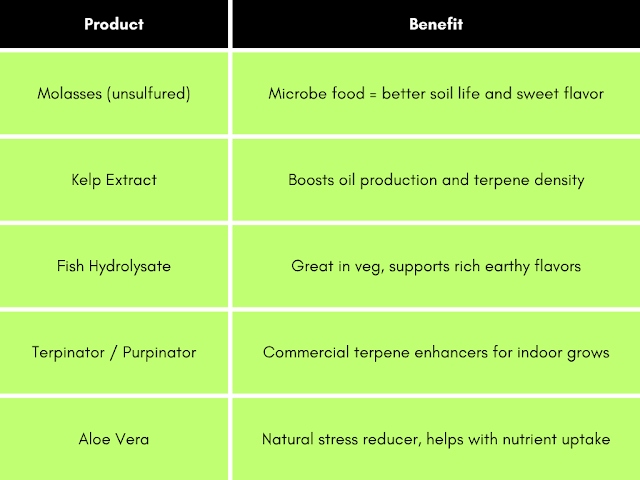Feeding for Flavor: Nutrient Tips for Tastier Indoor Bud in Rhode Island
Rhode Island’s indoor growers know the law limits plant numbers - but that just means every bud has to count. And if you’re looking to elevate your homegrown cannabis from “pretty good” to absolute fire, you can’t overlook one critical factor:
Flavor starts with feeding.
While bag appeal and potency matter, what separates a smooth, mouth-watering strain from dry, forgettable flower is how you nourish your plants - from root to ripening.Here’s how to feed your indoor grow for maximum flavor, aroma, and terpenes, with local conditions and legal limitations in mind.
1. Understand the Flavor Equation: Terpenes + Clean Feeding
Cannabis gets its flavor and aroma from terpenes - volatile compounds like myrcene, limonene, and linalool. The right feeding strategy doesn’t just boost yields - it amplifies terpene expression and avoids chemical residue that can ruin the taste.Key goals for flavor-forward feeding:
- Promote strong root health and microbial life.
- Avoid nutrient burn and excess salts.
- Encourage slow, natural ripening without rushing the plant.
- Minimize synthetic interference near harvest.
2. Choose Your Medium Wisely: Soil vs. Coco
In Rhode Island’s indoor grow spaces - think closets, basements, and tents - your grow medium impacts everything.Organic Soil (Best for Flavor)
- Allows for slow nutrient release.
- Encourages beneficial microbes that enhance terpene production.
- Less frequent feeding = more forgiving.
Look for:
- FoxFarm Happy Frog, BuildASoil Light Mix, or homemade compost blends.
- Pair with dry amendments like bat guano, worm castings, and kelp meal.
Coco Coir (More Control, Less Taste)
- Requires daily feeding, flush cycles, and strict pH monitoring.
- Flavor can still shine, but risk of salt buildup is higher.
3. Use Organic or "Clean" Nutrients for Terpene Retention
Synthetic nutrients can drive yield - but they don’t always translate to taste.Instead, use flavor-forward supplements that support:
- Aromatic compound formation
- Soil microbe health
- Stress resilience during flowering
Rhode Island-Friendly Flavor Boosters:
4. Feed in Phases – Match Your Inputs to Growth Stages
Vegetative Phase (Weeks 1–5):
- Prioritize nitrogen (N) for leafy growth.
- Add kelp, compost teas, and fish emulsions to prep the plant for strong terpene development later.
Early Flower (Weeks 6–8):
- Shift to phosphorus (P) and potassium (K) to support bud structure and resin production.
- Introduce molasses + aloe vera to feed microbes and ease stress.
Late Flower (Weeks 9–10+):
- Ease up on nitrogen, which can create harsh flavor if left too high.
- Keep P and K steady.
- Add finishing supplements like terpene boosters or natural sugars (molasses, honey, coconut water).
- Drop temperatures slightly during final week to preserve terpenes.
5. Flush Before Harvest - But Don’t Overdo It
A proper flush helps remove excess nutrients and salts, leaving you with clean-burning, flavorful flower. However, over-flushing or flushing too early can starve the plant during its critical finishing stage.Flushing Tips:
- 1–2 weeks before harvest, switch to plain, pH-balanced water.
- In soil: water with 3x the volume of the pot, slowly and evenly.
- Optional: Add enzymes or microbes to help break down salts during the flush.
- Look for yellowing fan leaves - a sign your plant is using up stored nutrients.
6. Environment Matters: Feed the Space, Not Just the Roots
Flavor doesn't come from nutrients alone - it thrives in the right climate. In a state like Rhode Island, where winter can be dry and summer is muggy, keep your grow tent or room dialed in:Use dehumidifiers in summer, humidifiers in winter, and always ensure strong air circulation to reduce terpene loss and mold risk.
7. Cure It Right - Because Even Perfect Feeding Can Be Ruined After the Chop
After all that effort, don’t ruin your hard-earned flavor by rushing the cure.Cure Like a Pro:
- Dry in 60–65°F, 50–55% RH for 7–10 days.
- Use glass jars, burping daily for 2–3 weeks.
- Store in a dark, cool place to preserve terpenes.
- Avoid plastic bags - they sweat and trap moisture.
Rhode Island Grows, Rhode Island Flavor
Indoor growers in Rhode Island are limited in plant count - but not in quality. With just 3 mature plants, you can still produce top-shelf, flavorful flower that rivals anything in a dispensary. And the secret isn’t in the strain - it’s in how you feed, flush, and finish your plants.We're HomeGrow Helpline and we help Rhode Islanders grow top-quality indoor cannabis - legally, confidently, and with expert guidance every step of the way.



.png)

Comments
Post a Comment